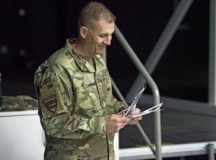 U.S. Air Force Chief Master Sgt. Jason Selman, United States Air Force in Europe-Air Forces Africa Chemical, Biological, Radiological, and Nuclear functional manager, taught a CBRN defense course on Ramstein Air Base, Sept. 24. Selman has taught CBRN courses for over 22 years.
U.S. Air Force Chief Master Sgt. Jason Selman, United States Air Force in Europe-Air Forces Africa Chemical, Biological, Radiological, and Nuclear functional manager, taught a CBRN defense course on Ramstein Air Base, Sept. 24. Selman has taught CBRN courses for over 22 years.
The CBRN course teaches Airmen how to survive and operate within a CBRN contested environment.
![]()
U.S. Air Force Chief Master Sgt. Jason Selman, United States Air Force in Europe-Air Forces Africa Chemical, Biological, Radiological, and Nuclear functional manager, demonstrates how to detach the drinking tube on a gas mask during a CBRN defense course on Ramstein Air Base, Sept. 24. The CBRN course teaches Airmen how to survive and operate within a CBRN contested environment.
![]()
Two chemical, biological, radiological, and nuclear defense course students perform buddy checks, Ramstein Air Base, Sept. 24. Buddy checks are completed to ensure CBRN gear is donned properly.
![]()
(Left) a portion of M8 chemical agent detector paper is placed on top of a stanchion on Ramstein Air Base, Sept. 24. The paper is used to detect chemical agents in the environment after chemical, biological, radiological, or nuclear attacks.
![]()
U.S. Air Force Chief Master Sgt. Jason Selman, United States Air Force in Europe-Air Forces Africa Chemical, Biological, Radiological, and Nuclear functional manager, teaches a CBRN defense course on Ramstein Air Base, Sept. 24. Selman has taught CBRN courses for over 22 years.
![]()
U.S. Air Force Chief Master Sgt. Jason Selman, United States Air Force in Europe-Air Forces Africa Chemical, Biological, Radiological, and Nuclear functional manager, left, and Lt. Col. Boris Shif, chief Intelligence, Surveillance, and Reconnaissance security cooperation division, right, inspect a gas mask together on Ramstein Air Base, Sept. 24. Air Force CBRN classes provide the tactics, techniques, and procedures to operate mission critical tasks within a CBRN degraded environment.
 U.S. Air Force Chief Master Sgt. Jason Selman, United States Air Force in Europe-Air Forces Africa Chemical, Biological, Radiological, and Nuclear functional manager, taught a CBRN defense course on Ramstein Air Base, Sept. 24. Selman has taught CBRN courses for over 22 years.
U.S. Air Force Chief Master Sgt. Jason Selman, United States Air Force in Europe-Air Forces Africa Chemical, Biological, Radiological, and Nuclear functional manager, taught a CBRN defense course on Ramstein Air Base, Sept. 24. Selman has taught CBRN courses for over 22 years.











